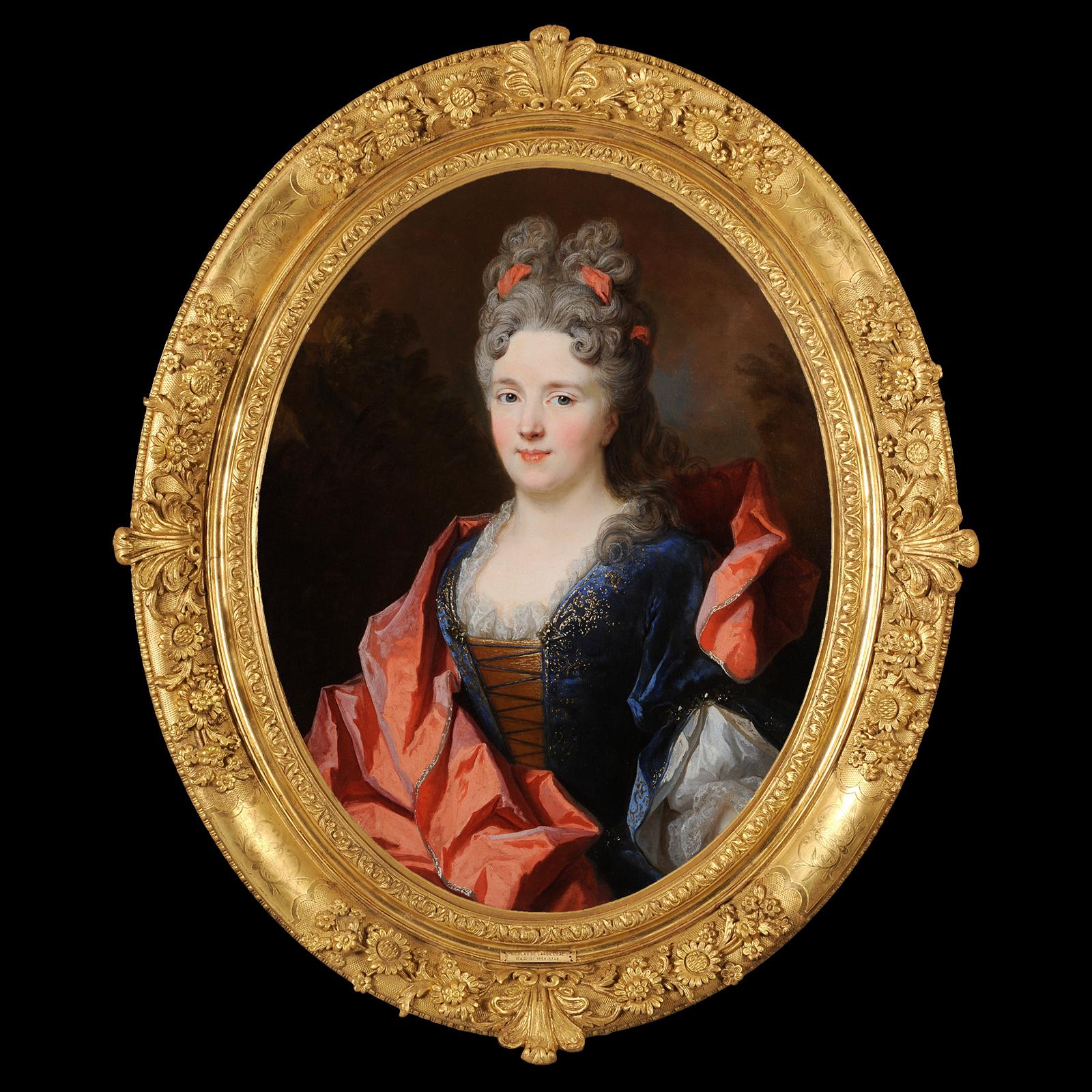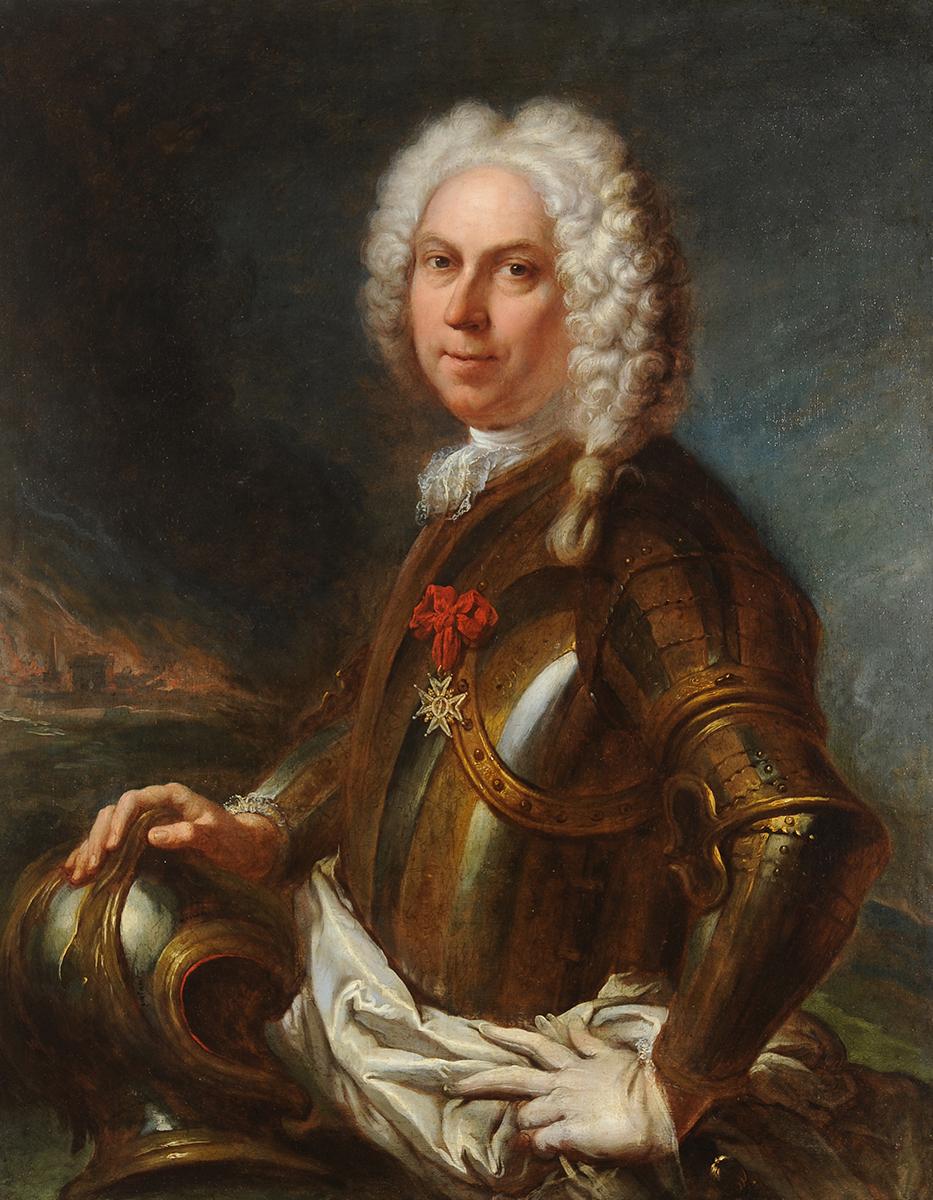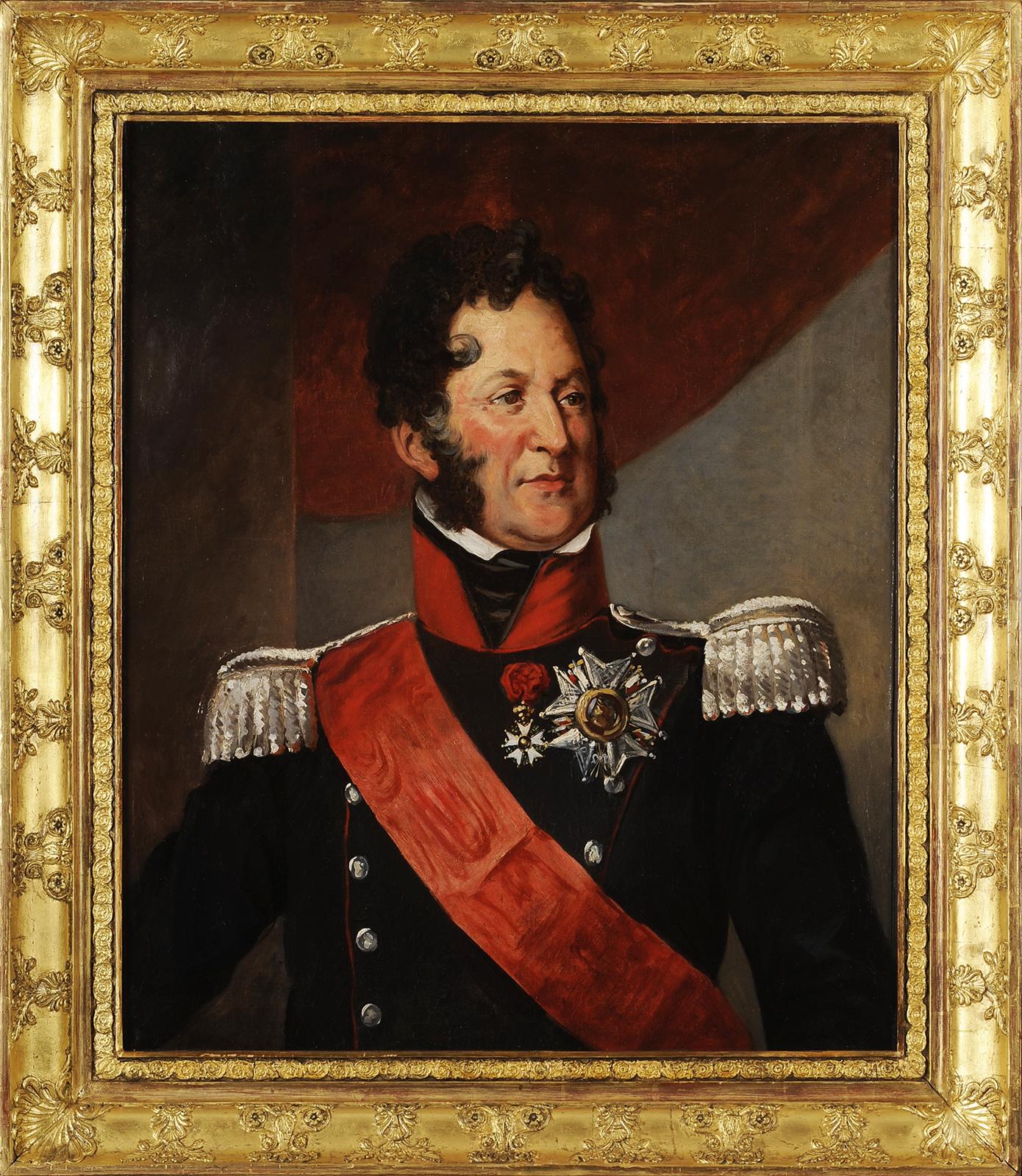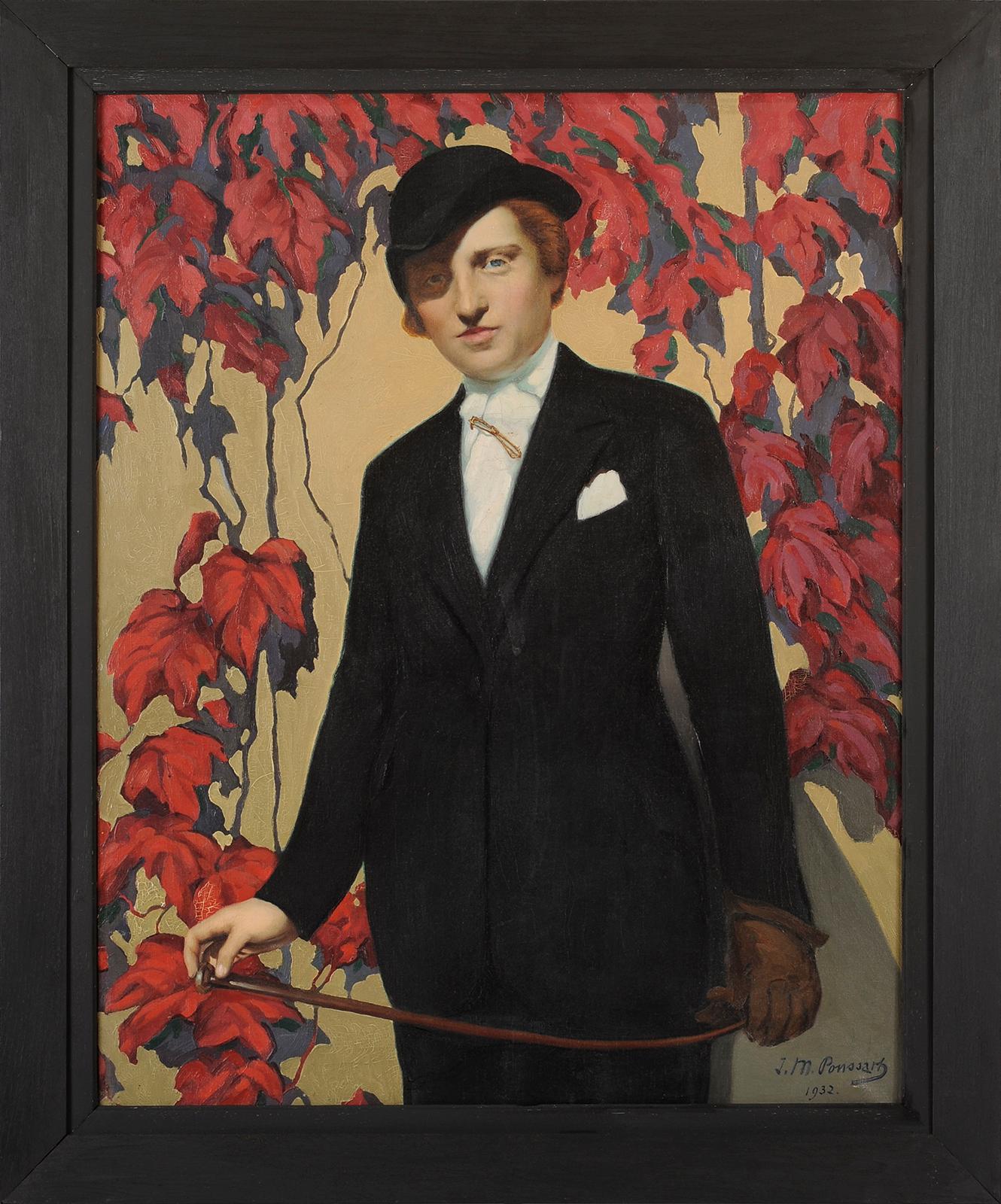Items Similar to 18th c. French School, portrait of a lady as Flora by Robert Le Vrac Tournieres
Want more images or videos?
Request additional images or videos from the seller
1 of 11
Robert Le Vrac Tournières18th c. French School, portrait of a lady as Flora by Robert Le Vrac Tournieres
About the Item
Portrait of a lady as Flora
Robert Le Vrac Tournieres (1667-1752)
First half of 18th century French School
Oil on oval canvas,
Dimensions: h. 27.2 in, w. 21.7 in
Magnificent original 18th century richly carved giltwood frame.
Framed : h. 36.61 in., w. 31.5 in.
Lovely half-length portrait of an aristocrat from Louis XV's court, disguised as Flora, goddess of spring.
Depicted down to the waist, she is dressed in a gray silk dress embroidered with gold threads around the slit. A large pink stole gracefully wraps her figure, while a garland of flowers descends along her shoulders.
With her head slightly tilted, turned three-quarters, the young woman gazes into the distance, which brings a dreamy effect to her large velvety brown eyes.
The artist's brush gently brushes her face with pearly pink reflections where the feverish red of the cheeks contrasts with the frosty gray of the powdery hair.
The freshness of youth and natural elegance emerge from this portrait where the artist, thanks to his skilful brush, animates the model.
Regarding the work of Robert le Vrac Tournières, please refer to the catalog of the exhibition of the Museum of Fine Arts in Caen: Robert Le Vrac Tournières, the facets of a portraitist, by Eddie Tassel and Patrick Ramade; June-September 2014 (Edition Snoeck 2014)
Robert LE VRAC TOURNIERES (Caen 1667-1752)
Son of a tailor from Caen, Robert Le Vrac trained with Bon Boulogne in Paris. He became a member of the Academy of Saint-Luc in 1695. The painter called himself Robert Tournières, this name designating the land of origin of the family, a place near Bayeux. He collaborated with Hyacinthe Rigaud and executed copies of his works in 1698 and 1699. He was received as a portraitist at the Academy in 1702. Tournières was noticed at the Salon of 1704 where he exhibited around twenty works, mainly portraits, individual or collectives, and history paintings. Ambitious and full of resources, Tournieres does not contain his talent in the narrow genre of portraiture, but touches on profane and sacred history, the specialty which earned him a second reception at the Academy as a history painter.
Despite this double admission, it was rather in the art of portraiture that he had a long and brilliant career, almost exclusively Parisian. For nearly half a century, an aristocratic and bourgeois clientele frequented his workshop. His singular and recognizable style while being faithful to the formulas defined by Rigaud and Largilliere reveal an honorable talent and know-how. A patient observer, he is known for his delicate colors, the flexibility of his brushwork and his elegant drapes.
Often neglected and misunderstood by art critics, unfairly relegated to the background in the face of the giants of the 18th century portrait, very little engraved by his contemporaries, his work comes out of oblivion and the homage was paid to him by the museum of Caen in 2014 with a monographic exhibition.
- Creator:Robert Le Vrac Tournières (1667 - 1752, French)
- Dimensions:Height: 36.61 in (92.99 cm)Width: 31.5 in (80.01 cm)
- Medium:
- Movement & Style:
- Period:
- Condition:Professionnally restored, cleaned and varnished. Ready to be hanged on the wall and appreciated.
- Gallery Location:PARIS, FR
- Reference Number:1stDibs: LU2433211932372
About the Seller
No Reviews Yet
Vetted Seller
These experienced sellers undergo a comprehensive evaluation by our team of in-house experts.
1stDibs seller since 2023
Typical response time: 1 hour
- ShippingRetrieving quote...Ships From: PARIS, France
- Return PolicyA return for this item may be initiated within 3 days of delivery.
More From This SellerView All
- 18th c. French Portrait of Princess of Bourbon as Hebe, Pierre Gobert, c. 1730By Pierre GobertLocated in PARIS, FRPortrait of Princess of Bourbon as Hebe Pierre Gobert, circa 1730 Presumed portrait of Elisabeth Thérèse Alexandrine of Bourbon-Condé, Mademoiselle de Sens, depicted as the goddess Hebe kidnapped by Zeus, transformed into an eagle. 18th century French School, around 1730 Pierre Gobert (1662-1744) and workshop Oil on canvas Dimensions: canvas: h. 129 cm, w. 95cm Dimensions: framed: h. 156 cm, w. 124cm Louis XIV style giltwood and cardved wood frame Large and imposing portrait of the young princess portrayed seated on an eagle in the heavens. Seen from the front, the princess is dressed in a low-cut white chiffon dress, exposing her throat. Delicately made-up oval face, dominated by large blue-gray eyes is surrounded by powdered hair, raised, releasing the forehead and the ears, and of which some locks fall on his shoulder. A large blue scarf passed over the shoulder covers her knees and flies in the wind. A garland of flowers coming from the back goes over the knees and down again on the eagle. In her right hand she holds a golden goblet and in her left hand an ewer. The eagle supporting the young woman seizes in its claws the thunderbolt (the beam of fiery lightning), the attribute of Zeus. The figure of the young woman is enlivened by the fluidity of the antique drapes...Category
Early 18th Century Old Masters Portrait Paintings
MaterialsCanvas, Oil
- French, circa 1730 Portrait of King Louis XV in armour, workshop of J.B. Van LooLocated in PARIS, FRPortrait of French King Louis XV (1710-1774) in armour 18th century French school Workshop of Jean Baptiste Van Loo (1684-1745) Circa 1730 Oil on canvas, dimen...Category
Early 18th Century Old Masters Portrait Paintings
MaterialsCanvas, Oil
- 18th c. French Portrait of a Lady as Venus, attributed to Pierre GobertBy Pierre GobertLocated in PARIS, FRPortrait of a Lady as Venus ATTRIBUTED TO PIERRE GOBERT (1662-1744) FRENCH SCHOOL AROUND 1720 OIL ON CANVAS: H. 55.51 in, W. 42.91 in. IMPORTANT 18TH CENTURY GILTWOOD FRAME (RE-GILT)...Category
Early 18th Century Old Masters Portrait Paintings
MaterialsCanvas, Oil
- 17th French Portrait of Louis XIV & his brother, c. 1645, attributed to BeaubrunLocated in PARIS, FRRare double portrait depicting Louis XIV and his brother Philippe de France as children. 17th century French School, circa 1645, attributed to Charles and Henri Beaubrun. Oil on canvas, dimensions: h. 48.03, w. 35.43 in. Important 17th century carved and giltwood frame Framed dimensions: h. 60.23, w. 48.42 in. This rare portrait is part of a series of works illustrating the childhood of the two princes, mainly commissioned by Anne of Austria, the mother and regent, after the death of Louis XIII. Expressing her fierce desire to preserve her son's crown, she uses visual communication as a channel of sovereign expression. The portraits serve to strengthen the royal power weakened by the minority of the young Louis...Category
Mid-17th Century Old Masters Portrait Paintings
MaterialsCanvas, Oil
- Portrait of count Evreux, French, 18th c. studio of Hyacinthe Rigaud, circa 1705By Hyacinthe RigaudLocated in PARIS, FRPortrait of Henri-Louis de la Tour d'Auvergne, Comte d'Evreux Studio of Hyacinthe Rigaud (1659-1743) Early 18th century French school, circa 1705 Oil on canvas Dimensions: h. 72 cm, w. 57.5 cm Louis XIV period gilded and richly carved wood frame with flowered corners. Framed: h. 96 cm, w. 80 cm Henri-Louis de la Tour d'Auvergne (1679-1753), Count of Evreux at the age of 24. The young man is depicted standing, seen at mid-height, turned three-quarters, against a background of a sky filled with cannon smoke. Head turned to the left, a large wig falling over his shoulders, a youthful face with plain cheeks, a delicate smile from thin lips, a gentle, benevolent facial expression. The right hand rests on the command staff in the foreground, while the left arm is bent and the hand rests on the hip. He is wearing a white sash of command, the floating drapery of which appears to his right. Fully armored, his only visible adornments are the blue velvet facings at the joins of the armor pieces and the sleeves of fine white lace. Power and charisma emanate from this military portrait. The young man's stature, bearing and head carriage convey the image of a valiant warrior. The theatrical lighting abundantly illuminates the face and creates strong metallic reflections in the armor. Despite his static stance, the hair blowing in the wind enlivens the painting, lending a dynamism and vigor that amplify the model's belligerent attitude. Our work is a studio version by Hyacinthe Rigaud, the original of which was executed by the artist himself in 1703. This original portrait of the Comte d'Evreux is now housed in the Gemälde Galerie - Alte Meister in the collections of the Kassel Museum. This portrait, one of the artist's most successful, was exhibited in 1704 at the Salon de l'Académie des Beaux-Arts and received rave reviews. As for the Compte d'Evreux, as soon as the original was created, he was satisfied with the artist's work and directly commissioned several replicas, which were executed by the studio between 1703 and 1705. These studio versions, as in the case of our painting, were intended as gifts from the Count to his wartime companions or members of his family. Our work is listed in the catalog raisonné of Hyacinthe Rigaud written by the artist's specialist Mr. Stéphane Perreau (published in 2004) Provenance: former private collection in Dijon, Burgundy Henri-Louis de la Tour d'Auvergne, le comte d'Evreux was the fourth son of the Duc de Bouillon, Godefroy-Maurice de La Tour...Category
Early 18th Century Old Masters Portrait Paintings
MaterialsCanvas, Oil
- Late 17th French Portrait of a gentleman, workshop of N. de Largilliere, ParisBy Nicolas de LargillièreLocated in PARIS, FRPortrait of a gentleman, workshop of Nicolas de Largilliere, circa 1690, Paris Sublime portrait of a gentleman with a palette of rich and vivid colors. He is depicted half-length, turned three-quarters, face to face. Soft and kind expression, the vivacity of the look, its calm serenity, grant an intense presence to the model. Wearing a loose wig of curly, powdered hair, this flow of vaporous curls cascades over his shoulder and enhances his face with regular features, illuminated by intense lighting and delicately nuanced by the gray tones of his emerging beard. Dressed in a shirt whose white lace collar can be seen, he wears a lapis blue velvet jacket with gold thread stripes and a moire silk lapel. Wrapped in a large red velvet coat, embroidered with silver thread, lined with brocaded yellow silk, held on his chest by a stapled leather strap. A delicate pink ribbon is passed through the collar of his shirt, the ends falling on the front like flying in the wind. Intense lighting concentrated on the figure plunges the background of the portrait into darkness. The dominant primary colors red and blue, chromatically opposed, are surprisingly harmonious and testify to the audacity of the artist who applies saturated colors to create a vibration of the material itself. The fabrics, the brushed velvet with ridges illuminated by generous serifs, the brocaded silk with a virtuoso brush, the lace and embroidery with a fine and precise design. A successful dazzle by the brilliance of the colors and a refined execution. French School circa 1690-1695 Workshop of Nicolas de Largillière (Paris, 1656-1746) Oil on canvas in oval shape H. 31.50 in, w. 24.40 in Carved and giltwood orignal frame with flower bouquets Framed dimensions: h. 41.73 in, w. 35.03 in Our work painted in the studio of Nicolas de Largillière, is marked by a learned eclecticism characteristic of this Parisian master. Inspired by the Antwerp Baroque masters Rubens and Van Dyck, the painter brings a spectacular dimension and seeks through the portrait to impress the viewer with its aesthetic and chromatic strength alone. We find his colors and this excution of baroque tradition in several portraits of this period, such as: Portrait of a gentleman, circa 1685, Chateau de Parentignat portrait of a gentleman, circa 1690, Atlanta Museum of Fine Arts portrait of a gentleman, Bemberg Foundation, Toulouse portrait of the Lord of Noirmont, National Museum of Ancient Art, Lisbon, Portugal Nicolas de Largilliere, born October 2, 1656 in Paris, where he died March 20, 1746, is a French painter. He is one of the most famous portrait painters of the 17th and 18th centuries. Nicolas de Largillière's long career spanned the reigns of Louis XIV and Louis XV, during which he established himself as a leading portrait painter. His female effigies...Category
Late 17th Century Old Masters Portrait Paintings
MaterialsCanvas, Oil
You May Also Like
- Model undressingLocated in BELEYMAS, FRJulius EXNER (Copenhagen, 1825 - Copenhagen, 1910) Model stripping Oil on canvas H. 122 cm; L. 74 cm Signed and dated 1842 lower right Exhibition: most likely Charlottenborg Salon of 1845, under number 110, titled Modelfigur, awarded with a silver medal Provenance: Emilio Fernando Bolt (c.1860 - 1944), acquired from the artist around 1900, then by descent Our painting was produced as part of the summer sessions organized between 1839 and 1850 by Christoffer Wilhelm Eckersberg (1783-1853), the master of Danish painting of the first half of the 19th century, in his private studio-apartment on the ground floor. floor at the Royal Academy of Fine Arts in Copenhagen. The master brought together a few students there between June and September, rented one or two models for the season, which were painted from different angles, the artists (including Eckersberg himself) sitting side by side. Eckersberg used to paint a fairly small version, the pupils of the larger formats. The work fits more generally into the legendary context of the research and reforms carried out by Eckersberg concerning the studies of nudes and in particular of female nudes, to make this exercise a genre of painting in its own right. Following his two-year stint in Jacques-Louis David's studio in Paris in 1811, Eckersberg had been made aware of work on the nude and in particular on live models, in natural light, while in Denmark the drawings were then only made from casts of antique models or other mannequins. In 1822, when he had been a professor there since 1818, it was he who had the Royal Academy of Copenhagen authorize the study of nudes, no longer in the evening by candlelight, but in natural light; from 1833, it was still he who allowed students to work on nude female models, even if the official authorization of the Academy did not take place until 1839. It was this same year that he instituted his summer sessions, on a private basis, to orient his painting and that of his students towards a new conception of the representation of models: even if the nude remains the real theme, it does not however, this is more than just an academic exercise. The subject is placed in a contemporary interior, with a rather sophisticated decor, and occupied with an intimate activity (it is this type of intimate vein that we will find later in Degas or Cassatt for example); thus in our painting, the young woman is supposed to take off her clothes to wash. The objective is that the viewer forgets that the master and his students are painting a model during a posing session, and that he instead has the impression of being alone with the model, but invisible, almost like a voyeur in spite of himself. Moreover, in these paintings, the model never looks towards the spectator, inducing a psychological distance with him, whereas model and artist are actually physically very close. On the other hand, it is not a question of idealized nudes either, even if Eckersberg, proof of his debt to the antique, chooses fairly classic models and poses. The sensuality is real and very present, with dreamy, even innocent, and timeless expressions (the models do not seem to have a defined age), suave and slow attitudes and movements, and especially with clothes that hide or reveal skillfully parts of the female body: upper buttocks, pronounced hips... Made by an artist under 20, our sensual painting is probably one of the most beautiful and spectacular produced by the students of Eckersberg during these summer sessions. With a perfect balance between the firmness of an ancient statue (it recalls the Venus de Milo) and the softness of the feminine forms, highlighted by a harmonious palette, it captures the attention with many details: the almost photographic folds white clothing...Category
1840s French School Nude Paintings
MaterialsCanvas, Oil
- Presumed portrait of Princess de Conti, Marie-Anne de BourbonBy Nicolas de LargillièreLocated in BELEYMAS, FRNicolas de LARGILLIERRE (Paris 1656 – 1746) Portrait of a woman, presumed to be Marie-Anne de Bourbon, Princess of Conti (1666-1739) Oil on oval canvas H. 80 cm; L. 61 cm (107 x 91 c...Category
1730s French School Figurative Paintings
MaterialsCanvas, Oil
- Portrait of a man in armorLocated in BELEYMAS, FRAttributed to Jacques DUMONT aka DUMONT LE ROMAIN (Paris 1701 - 1781) Presumed portrait of Louis-Joseph de Formanoir (?-1732) Oil on canvas H. 91.5 cm; ...Category
1750s French School Figurative Paintings
MaterialsCanvas, Oil
- French King Louis-Philippe - After Baron GérardLocated in BELEYMAS, FRAfter Baron Gérard, circa 1835 Portrait of King Louis-Philippe Oil on canvas H. 79 cm; L. 65 cm Provenance : Private collection, Périgord, by descent since the 19th century This po...Category
1830s French School Figurative Paintings
MaterialsCanvas, Oil
- Portrait of a woman in hunting in front of a vineyardLocated in BELEYMAS, FRJean-Marcel POUSSARD (1891-1972) Portrait of a woman in hunting attire in front of a vine H. 80 cm; L. 53 cm Oil on canvas Signed and dated lower right - 1932 Painter of portraits a...Category
1930s French School Figurative Paintings
MaterialsCanvas, Oil
- Portrait of a young girlLocated in BELEYMAS, FRLouis Joseph César DUCORNET (Lille 1806 – Paris 1856) Portrait of a young girl Oil on canvas H. 92 cm; L. 73 cm Signed upper left, dated 1837 When he came into the world in Lille in...Category
1830s French School Figurative Paintings
MaterialsCanvas, Oil
Recently Viewed
View AllMore Ways To Browse
Art As Antique
Antique Portrait 18th
Double Portrait
Antique Flora
Antique French Train
18th C Painting
Long Narrow Art
18th Century French Portraits
Oval Canvas
Antique Portraiture
18th Century Large Portrait
Lady Painting French Antique
18th C Portrait
Woman Oil Portrait Red
Very Large 18th Century Paintings
Antique Oval Portrait Frame
Aristocrat Art
18th Century French Portrait Painting





